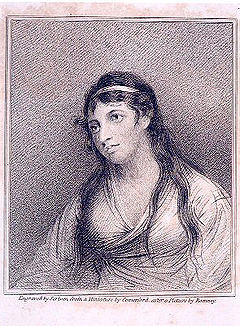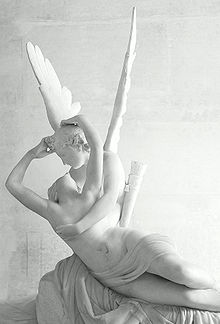- Mary Tighe
-
Mary Tighe 
Frontispiece portrait from Psyche, with Other Poems. 5th ed. London: Longman, Hurst, Rees, Orme, and Brown, 1816.Born 1772
Dublin, IrelandDied 1810
co. Wicklow, IrelandOccupation Poet Nationality Irish Period 1805-1810 Mary Tighe (née Blackford or Blanchford[1]) (October 9, 1772 – March 24, 1810), was an Anglo-Irish poet.[2]
She was born in Dublin to Theodosia Tighe, a Methodist leader, and William Blachford (d.1773?), a Church of Ireland clergyman and librarian. She had a strict religious upbringing, and when she was twenty-one she married Henry Tighe (1768–1836), her first cousin and a member of the Parliament of Ireland for Inistioge, County Kilkenny. The marriage is said to have been unhappy, though little is known.
The couple moved to London in the early nineteenth century. Tighe became acquainted with Thomas Moore, an early admirer of her writing, and others interested in literature. Although she had written since girlhood, she published nothing until Psyche (1805), a six-canto allegorical poem in Spenserian stanzas. Psyche was admired by many and praised by Thomas Moore in his poem, 'To Mrs. Henry Tighe on reading her Psyche'.[3]
Having suffered for at least a year, Mary Tighe endured a serious attack of tuberculosis in 1805.In February of 1805 Thomas Moore states that she had 'a very serious struggle for life' and in August of the same year that she was 'ordered to the Madeiras'. Moore also claimed that 'another winter will inevitably be her death.'[4] Tighe lived for another five years and spent her last few months of life as an invalid at her brother-in-law's estate in Woodstock,co. Wicklow, Ireland. She was buried in Initioge church, co. Kilkenny.[5] Her diary was destroyed, though a cousin copied out excerpts.[6]
The year following her death a new edition of Psyche was released, along with some previously unpublished poems; it was this edition that established her literary reputation. John Keats was one of her admirers and paid tribute to her in his poem, "To Some Ladies." Pam Perkins writes that "[d]espite the bleakness of many of the short poems in the 1811 volume, in much of the nineteenth-century writing on Tighe there is a tendency to make her an exemplar of patiently (and picturesquely) long-suffering femininity, a tendency exemplified most famously in Felicia Hemans's tribute to her, 'The Grave of a Poetess.'"[5]
Works
- Psyche, or the Legend of Love (Privately printed, 50 copies, 1805; republished posthumously in 1811 with other, previously unpublished works by Longman, London) Etext of Psyche from the 1811 ed.]
Psyche, or the legend of love is Mary Tighe’s rendition of the Greco-Roman folktale of Cupid and Psyche. The story is about a woman named Psyche who is so beautiful that the goddess Venus becomes envious of the attention that Psyche receives. Venus sends her son Cupid to Psyche in order to make her fall in love with a monster. Instead Cupid falls in love with Psyche and tries to keep it a secret but is inevitably found out by Venus who then sets Psyche various tests to complete. In the end Psyche is transformed into a goddess herself by Jupiter.
Tighe’s version explains how Cupid falls in love with Psyche. She only makes a few changes in the details from the original. When Cupid first goes to Psyche he comes equipped with water from a bitter spring from his mother’s garden along with his arrows. "The evil done now anxious to repair, He shed in haste the balmy drops of joy O'er all the silky ringlets of her hair."[7] She also makes allusions to Spencer’s Fairie Queene during Psyche’s final task set by Venus. "A cruel monster now her steps pursued, Well known of yore and named the Blatant Beast."[7]
- Selena (unpublished novel; MS in the National Library of Ireland)
- Mary: a Series of Reflections during 20 Years (Posthumous; edited and privately printed by her brother-in-law, William Tighe, 1811)
Notes
- ^ Simon Avery, 'Tighe [née Blanchford], Mary' in Lorna Sage, ed., The Cambridge Guide to Women's Writing in English, 1999
- ^ Biography
- ^ [1], English Poetry 1579-1830.
- ^ Moore, Thomas (1853). Memoirs, journal, and correspondence. Longman, Brown, Green, and Longmans. pp. 1.86, 90. ISBN 1103269534.
- ^ a b Pam Perkins, “Tighe , Mary (1772–1810),” Oxford Dictionary of National Biography. Ed. H. C. G. Matthew and Brian Harrison. Oxford: OUP, 2004. 14 Apr. 2007.
- ^ The U of Kentucky press released The Collected Poems and Journals of Mary Tighe, edited by Harriet Kramer Linkin, in 2005.
- ^ a b [2], Psyche; or, the Legend of Love.
Resources
- Blain, Virginia, et al., eds. "Tighe, Mary." The Feminist Companion to Literature in English. New Haven and London: Yale UP, 1990. 1081.
- Perkins, Pam. “Tighe , Mary (1772–1810).” Oxford Dictionary of National Biography. Ed. H. C. G. Matthew and Brian Harrison. Oxford: OUP, 2004. 14 Apr. 2007. The first edition of this text is available as an article on Wikisource:
 "Tighe, Mary". Dictionary of National Biography. London: Smith, Elder & Co. 1885–1900.
"Tighe, Mary". Dictionary of National Biography. London: Smith, Elder & Co. 1885–1900.
Categories:- 1772 births
- 1810 deaths
- People from Dublin (city)
- Irish poets
- Irish women writers
- 19th-century women writers
- Deaths from tuberculosis
- Women poets
- Infectious disease deaths in Ireland
- Irish women poets
- 18th-century Irish people
- 19th-century Irish people
Wikimedia Foundation. 2010.


